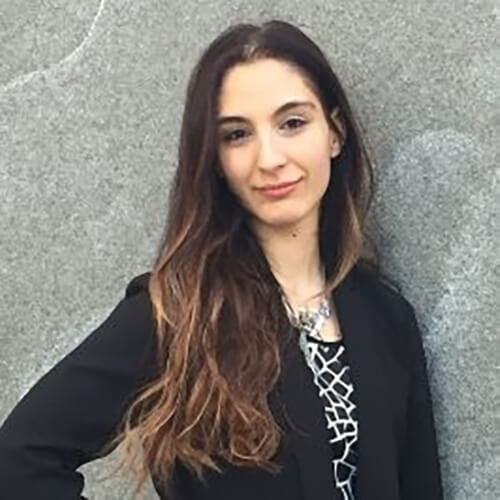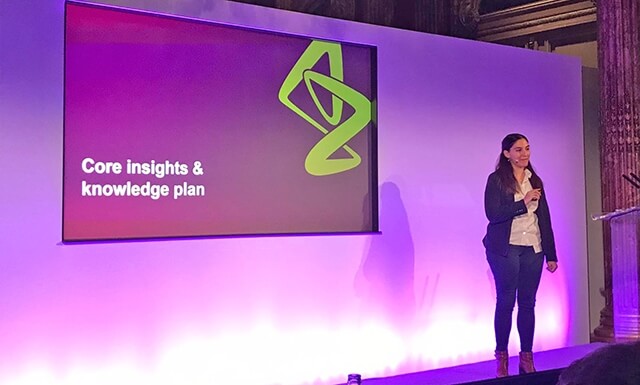One might say Nefeli Georgoulia’s research career began because she couldn’t speak Dutch.
A physics student during college in her native Greece, she enrolled at the University of Amsterdam in her final term through a study abroad program available in the European Union.
“All the undergrad courses were in Dutch, so that forced me to take graduate level courses,” said Georgoulia, S.M. ’13, Ph.D. ’14. “I started taking graduate level biophysics, genetics, and biology courses and surprised myself by how interested I became in biology.”
She had been curious about the world of health care since her youth, but gravitated towards math and physics because of their quantitative nature. Now with a blossoming interest in biology, and a few graduate courses under her belt, she joined a lab at the University of Amsterdam and pursued a master’s degree.
Georgoulia and her lab mates explored cellular processes through the lens of materials science. They studied cellular division and the cell cytoskeleton, seeking to understand the physical forces, like diffusion, at play in those processes.
“I really fell in love with the idea of research, which is something that I never set out to do,” she said. “For me, there was just something mesmerizing about looking at things through a microscope.”
On the advice of her advisor, Georgoulia applied for Ph.D. programs in the United States, and came to the Harvard John A. Paulson School of Engineering and Applied Sciences dead-set on digging into the latest materials science research.
But her path took an unexpected turn after she took a few classes in biomedical engineering, and saw how cutting-edge research was moving from bench to clinic and directly improving the lives of patients around the world.
“That really ignited my curiosity—that so much basic research was being conducted with the intention of solving real patient problems, either in drug discovery or diagnostics,” she said. “I remember that emotion to this day, because that is the emotion that seeded the rest of my career. My mind was blown and I knew I wanted to do medical research.”
So Georgoulia changed courses again.
Co-advised by Michael Brenner, Michael F. Cronin Professor of Applied Mathematics and Applied Physics and Professor of Physics, she joined the lab of Timothy Mitchinson, Hasib Sabbagh Professor of Systems Biology at the Harvard Medical School, and began working on her thesis project, which centered on cancer biology.
On her way to a Ph.D. in applied physics, Georgoulia studied the material shed by tumor cells, which is carried through a patient’s bloodstream. She explored the surface markers on these particles in an effort to uncover whether they could be targeted with specific drug therapies, or used to diagnose cancer mutations or drug resistance.
The work could someday help researchers and clinicians better diagnose and treat cancer with a simple blood test.
As she was wrapping up her thesis, Georgoulia began to feel restless again.
“I love doing experiments and I love the bench. The excitement I felt while looking through the microscope, it was still there, but I wanted to be able to have more impact,” she said. “I thought that going through the business side might enable me to have more impact in industry.”
Georgoulia gives a presentation at AstraZeneca. (Photo provided by Nefeli Georgoulia)
So Georgoulia took a “mini-MBA” course at the Harvard Business School and went on an entrepreneurship trip to New York City with a group of MBA students.
Those experiences helped her launch a career in health care consulting, where she worked on more than 30 projects over three years for a variety of pharmaceutical clients.
She and her colleagues would conduct research to help clients answer business questions, such as identifying several potential acquisition targets that could help a pharmaceutical company expand its respiratory portfolio, she explained.
Georgoulia now applies those same research and analytical skills at AstraZeneca, where she serves as associate director of oncology global analytics and insights. Working as part of a cross-functional clinical development team, she studies everything from current treatment methods for a disease, to patient and physician needs, to the horizon for drug development. Then she crafts scenario forecasting reports for management.
“Giving executives a sense of the opportunities and risks helps them know how to prioritize where to spend our limited funds,” she said.
For Georgoulia, it can sometimes be challenging to relinquish decision-making after she submits her analysis to her supervisors, especially after being used to designing and running her own research as a graduate student. She enjoys working with a diverse and multinational team at AstraZeneca, who bring many different backgrounds and ideas to the table. And staying close to the science helps feed her innate and insatiable curiosity.
“One of the most exciting things of working for a pharmaceutical company, you do feel like you are at the cusp of all of these new mechanisms that are coming out,” she said. “For me, with all of my scientific curiosity, my desire to be close to the health care field, and my love of numbers, this is a pretty sweet job. It really does play to my strengths and it is very rewarding.”
Press Contact
Adam Zewe | 617-496-5878 | azewe@seas.harvard.edu

